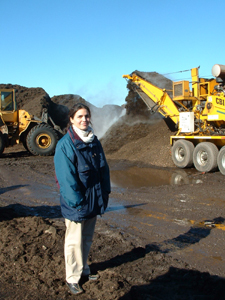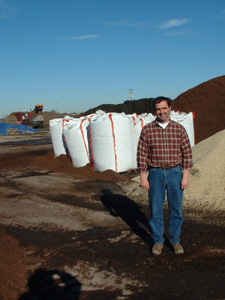by Diana Barnum

Mariana Asurmendi Slagter, M.S.., environmental Biologist for Kurtz
Bros.
Yard and landscape waste makes up approximately 18% of Ohio’s solid
waste and that number is growing, according to the Buckeye State’s
environmental protection officials. One waste-handling company decided to
do something about it and the effort has paid off in not only less fill
material, but a sizeable new revenue stream as well.
In order to reduce
and reuse that waste, Kurtz Brothers Inc. of Groveport, OH, diverts an
average of 100,000 tons per year of wood waste from local landfills with
natural recovery programs that reclaim organic materials from the debris
and then turns the valuable byproduct into profitable, enriched
mulch.
So far, the company’s recycling efforts over a 10-year period
reduced the local landfill’s anticipated full-capacity date by one year.
And future plans will hopefully save even more space and result in
additional natural solutions, say Kurtz officials.
“Our base product is
mulch made from 100% composted yard waste,” said Mariana Asurmendi
Slagter, M.S., environmental biologist at Kurtz Bros. Columbus Facility.
“It takes seven to nine months to get the finished product. We grind the
debris with CBI’s, then regrind a second time for better color and
marketing size.”

Operations manager Ed Williams with white bags of ball diamond clay
mix.
Photos by Diana Barnum
Kurtz Bros. operates several waste disposal sites throughout Ohio,
some focusing on yard-waste composting, where they manufacture and sell
various mulches, soils and ball diamond clay mix. Their natural products
contain nutrients, organic material and microorganisms that are beneficial
and “give back” to the soil and plant life.
They make colored
Amerimulch with biodegradable and environmentally safe coloring. Currently
green and blue are the newest colors in larger urban areas. Hardwood mulch
- black and red coloring – is popular in Columbus, Ohio.
One of the
first in Ohio to implement wood-waste recycling for mulch, Kurtz allows
free dumping from local homeowners.
Kurtz uses the heavy duty,
high-production CBI (Continental Biomass Industries, Inc.) Magnum Force
Series for primary and finish grinding: the 4000 Wood Hog, the 4800
Horizontal Hog and the 6000 HZ Hog.
The radio controlled, 74,000-lbs.,
road-legal Wood Hog boasts an 860-1030-hp Caterpillar 3412 Electronic
Diesel Engine; a patented upswing rotor that houses changeable tips and
hammers; a 16' x 60" Feed Conveyor with a high troughing side; a
pre-screener and hydraulic anvil.
The 89,000-lbs. Horizontal Hog has
the same engine and powerful upper and lower continuous feed rollers with
steel rotors to chomp up entire trees. And the 110,000-lbs. HZ Hog, with a
460-gallon fuel tank, boasts a 60-inch diameter, 25,000-lbs steel rotor
with 100% continuous feed of entire phone poles, trees and other huge
debris.
Afterward grinding comes custom screening with the new
prototype mobile CBI Galaxy Screener on wheels. Instead of a trommel, it
uses rubber stars that change sizes by speed control.
“Kurtz has the
first Galaxy Screener. It’s the world’s largest mobile Star Deck System,”
said Tim Griffin, sales engineer for CBI. “Kurtz is a long-time good
customer and really believes in us. They need really high-volume
equipment. If they’re down a day, they could be out thousands of dollars.
We over-build our equipment so it lasts.”
The engine is a 190-hp John
Deere and the Star Deck length measures 30’ with a 43” width. The
44,800-lbs. machine has a 10.25-cubic-yard hopper. Move it and set up in
10 minutes.
Mobility is important around the large work area at Kurtz
where giant hills of compost and debris bear testimony to their
high-volume operation. These hills also reveal one of the secrets to
knowing whether or not the pile contains wood or yard matter: steam.
Bacteria, moisture, oxygen and yard waste generate between 100-degrees and
140-degrees F, generating steam visible around the mounds.
“A wood
pile of mulch does not generate the heat steam,” explained Slagter, “In
other words, there is not enough nitrogen for your plants.”
Besides the
hills, Kurtz uses another popular method of composting, windrow tunnels,
as spacing in their developed area within their 100-acre site allows.
Windrow tunnels produce a chimney effect with free air circulation, which
is what bacteria needs in order to not produce a foul smell.
Regardless of the recycling method, though, clean is an operative word
in the process. Many people drop off waste that contains plastic, mostly
the small bags from grocery stores. Whether the bags were part of the
loading process and tossed in accidentally, or whether they were simply
left lying in the bottom of truck beds and trailers at the time of loading
and accidentally found their way into the trash pile, is uncertain. But
the result is an end product good possibly for low-grade filler dirt in
which grass can grow, rather than mulch.
Kurtz also grinds up pallets.
After two rounds, they are used in making colored mulch. Future plans
include developing technology that would allow workers to sort out pallet
wood debris from scrap metal. A clean, safe and inexpensive method is
needed to remove the wood contaminant so that the metal can be
reused.
For more information about natural solutions for wood waste,
contact Kurtz Brothers Inc. at 2850 Rohr Road, Groveport, OH 43125. Call:
(800) 527-6457, or fax inquiries to: (614) 491-0878. Visit them online at
www.kurtz-bros.com.
To learn more about the new Galaxy screen, contact
Continental Biomass Industries, Inc. at 22 Whittier Street, Newton, NH
03858. Call: (603) 382-0556, or fax inquiries to: (603) 382-0557. E-mail
inquiries to: info@cbi-inc.com.
|